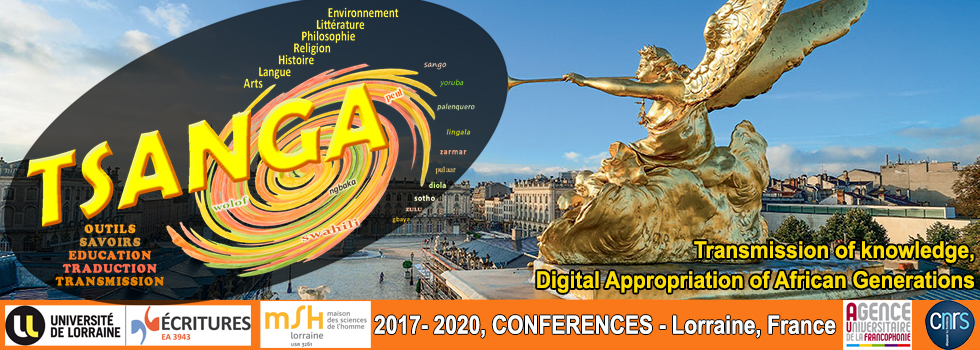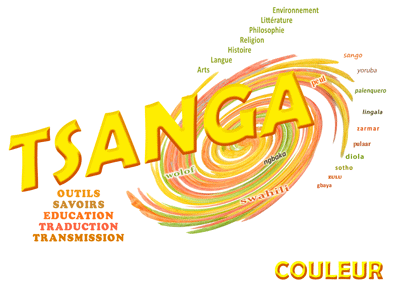
Main menu
HELP
|
visiting
Perception and categorization-denomination Colors "Colors and human relationships: Men for projects, projects for men" Appropriation of knowledge in contexts of Europeanand contemporary expansion (XV e-XXIe), colours as a "glocal" language,
Colors, cultural hybridities-reidentifications:
international seminars integrated into the "TSANGA Meetings" The fundamentals of the project: How is the transmission of knowledge ensured in a global multi-cultural context subject to the impact of the circulation of populations, the means of information and communication and therefore cultural representations? The least astute observer has noticed in recent years that the advent of digital technology and new digital interfaces is rapidly reducing the divide between both the countries of the South and the North and between generations. However, if the contribution of digital technology can no longer be ignored, the culturalist approach still seems to be prevalent in the appropriation of knowledge, especially in contexts related to cultural contacts (European expansions, internal displacements and countries in the south and north). From then on, in this globalizing landscape emerges a hybrid space where digital is rubbed shoulders with the culturalist in the appropriation of knowledge. This mixing game is difficult to manage because it can open the doors to a cultural and linguistic disinheritance in which deculturation, in the sense of lack of cultural identity, can play a fundamental role. This new space can lead either to a controlled management of learning, learning and skills or to an accumulation of preconceived ideas in the construction of knowledge. The current context for the circulation of cultures is prompting a reconsideration of some key concepts and cultural approaches. Indeed, the mix of cultural entities, the integration of new generations, the demographic explosion of emerging countries[2] and the increase in north-south and south-north mobility of populations challenge the old scientific theories relating to the study of cultures and countergeneralize widespread assumptions. These last two parameters form the basis and the main issue of our questions. In this sense, colour is one of the most significant examples. Indeed, one would like to believe that there are originally only three colors (Black, White, Red) perceived and referred to in Sub-Saharan Africa or that "everything is colour"; that the representation-perception and denomination of colours are almost similar in this vast continent and that, while there are differences in perception, they have only a minor impact on language, cultural, social and economic exchanges during daily and professional activities North-South and South-North. The reality is quite different and is little studied. In fact, europe can provide and render important colour data of conceptual, linguistic, historical, anthropological, artistic, physiological, medical, commercial, etc.[3], as much as the studies carried out in Sub-Saharan Africa are indigent, even unknown. Thus, the multidisciplinary scope of exploitation that Africa offers in relation to the color study remains vast. Over the past fifteen years, the language and societal policy approaches put forward for the treatment of lexicon, literary objects and descriptions of endangered and/or vehicular vernacular languages (including officials) have resulted in the massive recruitment of research teachers in emerging African countries (Senegal, Côte d'Ivoire, Gabon, Cameroon, etc.). It opens up the production of many knowledge andskills. Thus, it goes without saying that the accentuated and operational exchanges via the appropriation of digital technology will only grow. We observe, however, major obstacles in the understanding of the restitution and perception of colors: - the complexity of the treatment of the color theme, the structuring of cultures by orality, the quantitative weakness of paper or digital traces of description of literary and physical works and the absence or even the lack of results of inter- and multidisciplinary research on the impact of colour in urban ecology and rural areas). There is an urgent need to address this. Indeed, we cannot ignore theimpact of color in social history and societal perspectives. [Color is totally and remains integrated into our landscape, permeates our daily lives (language, art, architecture, food, etc.). It constantly influences our needs, our dislikes, our lifestyles, our tastes (aesthetic, literary, artistic, etc.), even our judgments]. Therefore, it interferes in the need to better understand us, the dialogue and the consequences it can engender in our cultural-intercultural exchanges and the economic development of our organizations.
The innovative TSANGA project scheme seeks to activate, enhance and build links between research activities, training and professional development from the University of Loraine (via the Scripture Centre) in partnership with currently 5 independent teams from Côte d'Ivoire, Cameroon, Senegal, Benin-Togo, RCA[5]. Thanks to these many colleagues, the fields of research conducted with field surveys will lead to a better understanding of the influence of colour in local, global and international intercultural contexts.
The project focuses on three activities: 1. "TSANGA Meetings" which induce a work of theoretical reflections and methodological approaches to address the federal topic of research, "COULOR" are the international exchange events with five thematic symposiums and an international congress from 2017 to 2021. November 8, 2017 Perception and categorization-denomination Colors: "Methodology of Action, Vision, Perception,» and "Light and/or Tint, Denominations and Complex Realities in», Place: Maison des Sciences de L'Homme - Lorraine in Nancy, organized by Sylvie Grand'Eury-Buron and Erick Cakpo 7-9 November 2018, Colors and Human Relations: Men for Projects and Projects for Men, ARTEM Location - PeeL in Nancy, organized by Sylvie Grand'Eury-Buron, Erick Cakpo and Yves Buron 29-31 October 2019, Appropriation of knowledge in contexts of European and contemporary expansion (XVe-XXIe s), colours as "glocal" language, Hassan II University, Casablanca-Morocco, organised by Sylvie Grand'Eury-Buron, Erick Cakpo, Salah Koubaa, Yves Buron 12-14 November 2020, Colors, relevance of usages and habits in the translation of religious and teaching documents, Place Maison des Sciences de L'Homme - Lorraine - Nancy (a) vril-May 2021, Colors, contemporary reappropriations (indigenous or allochtone) to promote the creation, transmission of knowledge and the development of artistic and literary works, Place MSH - METZ; August 2021, World Congress "Color in the transmission of contemporary knowledge in sub-Saharan Africa: education, training, territory, health," Lieu Université Alassane Ouattara - Bouaké - Côte d'Ivoire 2. the federal space with the Exchange-TSANGA platform for the individual and/or collaborative exploitation of scientifically disseminated data and the creation of online courses (proposals for complementary modules or microprograms validated as diploma supplements to promote intercultural openness and international mobility): :
In addition, the selected articles, derived from the various researches taking place as part of this project, will then be published in open access on international sites. 3. logistical support for:
[1] TSANGA members of UNC Sections 06, 07, 10, 12, 14, 15, 16, 17, 18, 19, 20, 21, 22, 23, 66, 68, 69, 67, 70, 71, 76, 77, 86 / Management Sciences, Language Sciences, Germanic Language and Literature, Romance Languages and Literature, Arabic Languages and Literature, Hebrew, Psychology, Philosophy, Architect-Arts, Sociology-Demography, Ethnology-Prehistory-Anthropology, History-Civilization-Civilization and Art of the Ancient Worlds, History and Worldart- Contemporary, Physical-Human-Economic and Regional Geography, Physiology, Agency Biology, Neuroscience, Population Biology and Ecology, Educational Sciences, Information and Communication Sciences, Catholic Theology, Protestant Theology and Pharmacy in Drug Science and Other Health Products.
French language - Interpretation LSF |


